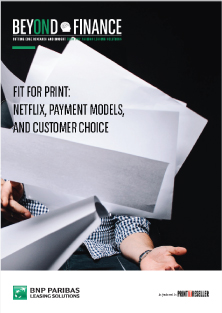Drawing your technology roadmap
So how can businesses afford the latest technology?
Purchasing office technology outright has several drawbacks. The allure of ownership tends to fade when measured against its costs. Even if a company has the money to buy new-to-market, advanced equipment up front, the expense does not end with the initial transaction.
Implementation takes time, costs money, and may require expertise that the business does not have. Maintenance and support are always ongoing considerations. Even if there are no breakdowns or issues, old models are eventually replaced by new ones – meaning the business must fork out for the latest technology or risk falling behind their competitors. There’s also the issue of company growth: if an organisation is expanding at a rate that outpaces its technology setup, efficiency is often the main casualty.
With obsolescence and frustration seemingly built-in, the costs of new technology may seem unjustifiable to customers. But technology isn’t unaffordable: businesses just need to find new ways to afford it.
Leasing is already popular in the market, and this popularity is steadily growing. The value of financing new technology without a huge upfront outlay is appealing to VARs and their end-users alike. In fact, the Finance and Leasing Association (FLA) reported a 6% increase in business equipment finance in June 2017 compared to the previous year.
Benefits for end-users
Businesses that finance their technology in this way benefit from predictable, transparent costs and terms: agreeing to monthly payments across a pre-determined contractual length, they can spread the cost of technology as far as they need to. Furthermore, it often represents a better deal for these businesses: implementation, maintenance, and other value-add services can be rolled into the initial contract – safeguarding against the possibility of any potential breakdowns or setup issues.
More than anything, though, alternative financing models like this unshackle companies from commitment. A business can often find itself in a marriage of convenience with its creaking, outdated machines: they’re too expensive to replace – in some cases, too expensive to even dispose of – but too old to scale up. Leasing allows companies to upgrade as soon as the contractual period ends – meaning your end-users aren’t wedded to equipment that no longer serves their interests.
Benefits for VARs
For VARs, this model also offers several advantages. Leasing encourages long-term customer loyalty: a single purchase may be a mutually beneficial one-off affair, but finance agreements spread across a period of one to three years helps them to form meaningful relationships.
Being able to add soft costs such as consultancy, training and implementation into any arrangement will naturally appeal to customers, who increasingly want more from their dealings with suppliers. When VARs can give it to them, they’re also in a better position to make the most of up-sell and cross-selling opportunities where appropriate.
A new lease on corporate life
Leasing also supports a more sustainable approach to office technology: it provides a clear alternative to the traditional, wasteful economic model in favour of a ‘circular’ approach that prioritises maintenance, reuse, refurbishment, and recycling.
Both the office equipment industry and its customers stand to benefit from exploring alternative financial options. Technology is seldom as expensive as we think it is: if we balk at the upfront cost of an item, there are often other ways to secure it. Make your customers aware of their options, and they’re more likely to exercise them.
empowered to use my years of knowledge in the sector to help drive the ICT business forward. My first few weeks in the role have been fantastic and I’ve really enjoyed the challenge of better understanding the business as well as meeting our partners. BNP Paribas is a great brand in the market and I’m looking forward to helping the team expand our existing relationships, opening new ones and growing this important segment of the business.’’


 In this article we explore the
In this article we explore the 



